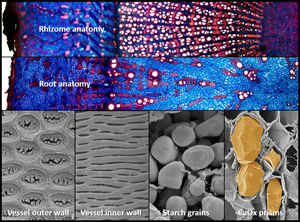Article contents
Application of Microscopy in the Quality Control of Licorice Roots: Comparative Anatomy of the Roots and Rhizomes of Five Species of Glycyrrhiza
Published online by Cambridge University Press: 08 September 2022
Abstract

The raw materials of “licorice root” in the commerce consist of roots and/or rhizomes (stolons) of different species of Glycyrrhiza. Licorice products and raw materials are frequently mislabeled and often have mixed, misidentified, or unidentified species and parts. This paper provides a detailed comparative analysis of the morpho-anatomies of the rhizomes and roots of five species of Glycyrrhiza, namely G. glabra, G. uralensis, G. echinata, G. inflata, and G. lepidota, by bright-field light microscopy and scanning electron microscopy. The studied species showed some similarities in their basic anatomical features due to the fact that they are phylogenetically closely related and belong to the same genus. However, differences in microscopic features such as the thickness of cork and medullary rays, pore frequency, and size of the vessels were observed. The rhizomes can readily be distinguished by the presence of a distinct pith. The roots lack a well-defined pith and instead have primary xylem in the center.
Keywords
- Type
- Micrographia
- Information
- Copyright
- Copyright © The Author(s), 2022. Published by Cambridge University Press on behalf of the Microscopy Society of America
References
- 1
- Cited by





